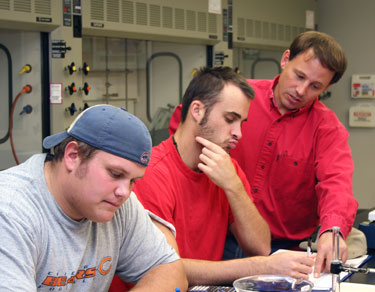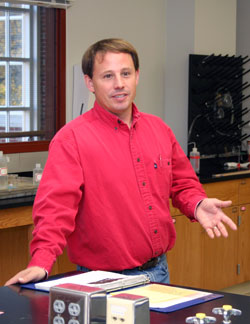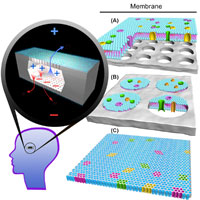Imagine a future where you take a capsule filled with tiny devices that can diagnose your illness. Or you’re battling cancer and doctors use a microscopic device to deliver medicine only to the cancerous cells.
Wabash College Associate Professor of Chemistry Scott Feller is a member of a team of researchers that recently received a five-year, $6.5 million grant from the National Eye Institute of the National Institutes of Health. The team’s project is part of the National Center for Design of Biomimetic Nanoconductors.
 Feller will be working on the marriage of biochemistry and technology along with researchers, engineers, and medical specialists from Yale, Purdue, Southern California, Cornell, Kentucky, and Oxford in the United Kingdom among others.
Feller will be working on the marriage of biochemistry and technology along with researchers, engineers, and medical specialists from Yale, Purdue, Southern California, Cornell, Kentucky, and Oxford in the United Kingdom among others.
"People can now do amazing things designing small features in silicon," Feller explained. "What we’d like to be able to do is take devices that you could make with inorganic material and layer these — or lay on top of these — biological materials."
"My area is to try to understand on a very fundamental level how these biological materials will interact with silicon. What would it take to get this biological membrane to adhere to this silicon system? What does the affect of the silicon have on the membrane?"
Feller explains the researchers hope to "steal from biology the good engineering that nature has done to form barriers and selectively let things in and out." He goes on to say that "the challenge is to create really small devices that also can be compatible with biological systems so they might have medical applications."
 The five-year grant is supporting a multidisciplinary and multi-institutional project to design, model, synthesize, and fabricate nanomedical devices based on natural synthetic ion transporters, proteins that control ion motion across the membrane of every living cell.
The five-year grant is supporting a multidisciplinary and multi-institutional project to design, model, synthesize, and fabricate nanomedical devices based on natural synthetic ion transporters, proteins that control ion motion across the membrane of every living cell.
To put Feller’s research into perspective, nanomedicine operates at the biological molecule scale of 100 nanometers or less to cure disease or repair damaged tissues. A nanometer is one-billionth of a meter.
Feller has a small but added advantage in his research. His colleague, Lon Porter, a Wabash assistant professor of chemistry, has been conducting research in nanotechnology — or the inorganic side of the marriage of biochemistry and technology.
"Actually my research interest goes the opposite direction of what Lon and people who make molecules do," Feller said. "They keep coming from the bigger materials and make them smaller and smaller. They’re now able to make things really small. My research is more in the area of the properties of individual molecules."
The marriage of the organic and inorganic in nano size opens up potentially historic medical progress. The first goal of the grant is to design devices for generating electrical power for implantable devices, including an artificial retina. Future uses could include sensors, power sources, energy transducers, and osmotic pumps which could be used as research platforms or a new generation of implantable medical devices.
 The more immediate impact for Wabash will be student research assistants for Feller along with a broader understanding of how science works in the real world.
The more immediate impact for Wabash will be student research assistants for Feller along with a broader understanding of how science works in the real world.
"I like the idea we could do some basic physical chemistry research, very fundamental research on interaction between molecules, but then there would be immediate use for that," Feller said. "The people at Yale and Oxford, who are more involved in the engineering side, will immediately use the basic research."
Feller said students also will be able to see how research is a collaborative effort.
"Science is not done by one person in one lab. In fact, it’s a complicated web of people designing things and pushing for more information. I hope we get an idea of what’s involved in modern day science. It involves lots of different people."
The end result could be years or decades away, Feller admits. He said it’s possible the research could lead nowhere, but this type of exploratory research is necessary to jump start medical care and technology for the future.
Hewitt is Wabash College Director of New Media/Web Editor.
In photos: Scott Feller works in a lab with Luke Lukasik '06 and Gabe Surface '06.
In graphic: Figures A and B represent attaching organic material to the inorganic nano device while Figure C would be the marriage of the two.